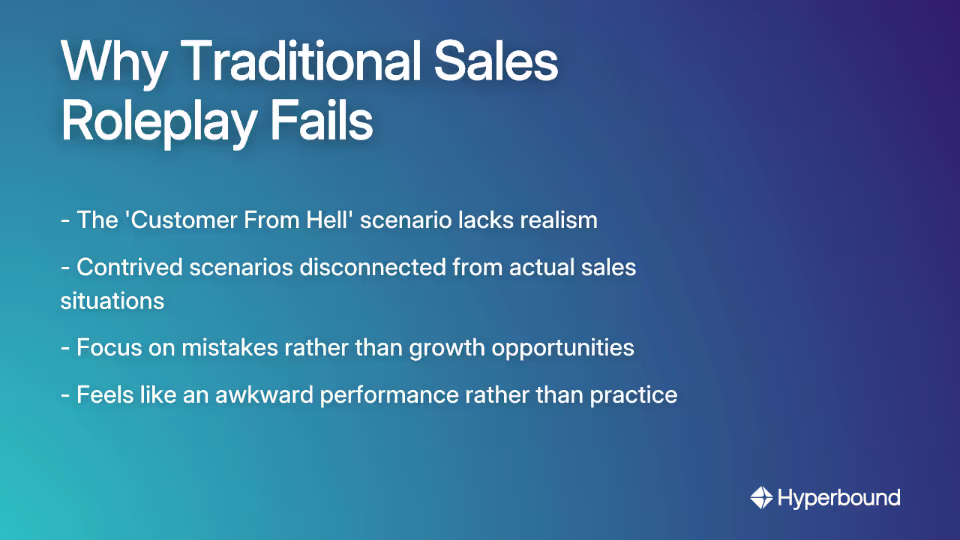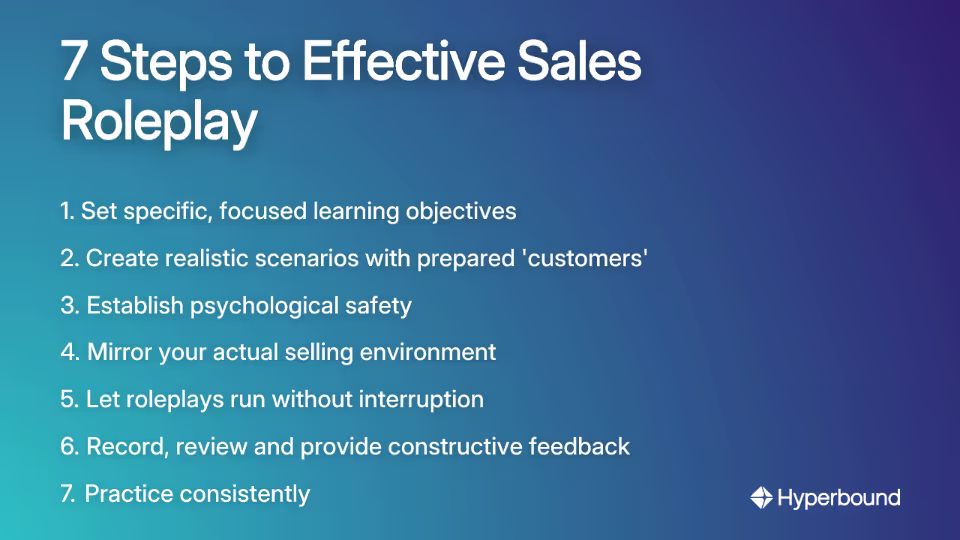.avif)
You've been there. The meeting invite lands in your calendar with those dreaded words: "Sales Roleplay Session." Your stomach tightens. You immediately think about how to call in sick that day.
"It's freaking awkward," as one sales professional puts it. Or as another rep bluntly states, "Roleplay is awkward and a waste of time. It's designed to make you do something wrong."
If you're nodding in agreement, you're not alone. The baptism by fire that most sales teams call "roleplay" often feels more like negative reinforcement than productive training. But here's the truth: the problem isn't roleplay itself—it's how most organizations execute it.
Why Most Sales Roleplay Fails (And It's Not Your Fault)
The discomfort of roleplay runs deeper than simple awkwardness. As one SDR explained, "Everyone will say they hate it because it's awkward, but in my experience, that hate comes more from the fact that it makes you vulnerable in front of your peers."
But vulnerability isn't the only issue. Most roleplay sessions fail because:
1. The "Customer" From Hell
Your colleague playing the prospect either becomes an unreasonably difficult customer ("No, I don't have that problem. No, I don't have budget. No, I'm not interested.") or a completely passive participant who gives you nothing to work with. As one frustrated rep described it, "The worst is when the person playing the customer defaults to the most difficult, totally unworkable person to the point of unrealism instead of trying to simulate a real human conversation."
2. Scenarios That Bear No Resemblance to Reality
Many sales enablement programs create scenarios that feel like they were written by someone who's never actually spoken to a customer. "The scenarios most companies come up with are usually too far removed from reality to be useful," says one experienced account executive.
3. A Focus on Failure Rather Than Growth
Too often, roleplay becomes a "gotcha" exercise where managers look for mistakes rather than opportunities for improvement. This turns what should be a learning experience into a stressful performance review.
For relationship-based sales with long cycles, many reps believe "roleplaying is just a waste of time" when structured poorly. It feels like a cheap replacement for actual sales training rather than a valuable tool in itself.

The Hidden Value: Why Well-Structured Roleplay Is Worth Your Time
Despite these frustrations, well-designed roleplay sessions can transform your sales team's performance. Here's why:
Active Learning Beats Passive Listening
When reps practice a discovery call or handle customer objections in roleplay, they engage in active learning—which is far more effective than passively watching training videos or listening to lectures. This deliberate practice builds muscle memory for real sales situations.
It Builds Resilience Under Pressure
Ironically, performing in front of peers can feel more stressful than an actual client pitch. This low-stakes pressure cooker builds resilience that translates directly to real-world confidence. Data shows that sales reps who participate in regular, structured roleplay can improve their performance by as much as 24%.
It Develops Critical Empathy
When reps take turns playing the customer, they gain invaluable perspective on the buyer's journey. This empathy helps them recognize buying signals and address pain points more effectively during actual sales calls.

The Manager's Playbook: 7 Steps to Roleplay That Actually Works
Here's how to transform dreaded roleplay into your team's most powerful development tool:

Step 1: Set Specific, Laser-Focused Goals
Don't just "practice selling." Each roleplay should target 1-2 specific skills.
Manager Action: Define clear objectives like "In this scenario, the SDR must successfully handle the pricing objection and maintain control of the conversation while demonstrating value beyond cost." This focused approach prevents overwhelm and enables meaningful feedback.
Step 2: Craft Realistic Scenarios (and Prepare the "Customer")
Pull scenarios from your team's actual experiences—recent wins, losses, or stalled deals make perfect material.
Manager Action: Create a detailed brief for the person playing the customer, including:
- Company background and buyer persona details
- Specific pain points they're experiencing
- Budget constraints they're working with
- Exact objections they should raise
- How responsive or resistant they should be
Without this preparation, your "customer" will default to unhelpful extremes. To save time and ensure relevance, platforms like Hyperbound can analyze your team's winning conversations to automatically create realistic practice scenarios.
Step 3: Create a Psychologically Safe Environment
This is where most managers fail—and it's the most crucial element for success.
Manager Action:
- Lead by example: Start by doing a "showcase roleplay" yourself. Show vulnerability by making mistakes and receiving feedback.
- Frame failure as learning: Explicitly state that mistakes are expected and valued as learning opportunities.
- Allow "timeouts": Let reps pause the roleplay to ask for help or regroup without judgment.
As one sales leader noted, "When my team sees me stumble through a tough objection in roleplay and laugh it off, suddenly everyone's anxiety level drops by half."
Step 4: Practice the Way You Actually Sell
The format should mirror reality as closely as possible.
Manager Action: If your team sells over Zoom, conduct the roleplay on a video call. If they cold call prospects, have them dial in. Use the actual tools—pitch deck, value proposition slides, product demos—they would use in a real sales process.
Step 5: Run the Session Without Interrupting
Let the roleplay unfold naturally without constant correction.
Manager Action: Observe and take detailed notes. Consider using different formats:
- Triad Roleplay: Groups of three (Salesperson, Customer, Observer) who rotate roles, providing peer feedback from multiple perspectives.
- Team Observation: One rep roleplays while others observe and provide structured feedback afterward.
Step 6: Record, Review, and Give Constructive Feedback
This is where the real learning happens.
Manager Action:
- Record and score every session: Use a platform with AI Real Call Scoring to automatically analyze roleplays against your custom playbook. This provides objective, data-driven feedback and saves managers hours of review time.
- Give instant, constructive feedback: Reps shouldn't have to wait for a manager. With an AI Coach, they get immediate, personalized tips after every practice session, allowing them to rapidly iterate and improve.
Step 7: Make It a Habit
Consistency transforms roleplay from a dreaded event into a routine growth opportunity.
Manager Action: While live sessions are great, consistency comes from on-demand practice. Supplement team roleplays with a tool like Hyperbound's AI Sales Roleplays that allows reps to practice anytime, anywhere. This builds familiarity, reduces anxiety, and compounds skill development over time.
5 High-Impact Roleplay Scenarios to Use Today
Ready to put these principles into practice? Here are five scenarios your team can start using immediately:
1. The Discovery Call With Hidden Needs
Goal: Master the art of asking probing questions to uncover unstated pain points during lead generation efforts.
Example Snippet: "I appreciate you sharing that challenge around [stated problem]. Many [similar companies] we work with initially focus on that, but often discover that [related, deeper issue] is actually costing them more. Is that something you've experienced as well?"
2. The Price Haggler (Objection Handling)
Goal: Defend your value proposition without reflexively discounting.
Example Scenario: The prospect says, "Your competitor is offering something similar for 20% less. Why shouldn't I go with them?"
3. The Multi-Stakeholder Negotiation
Goal: Navigate conflicting priorities from different members of a buying committee during the sales process.
Scenario: Three team members (CFO, end user, and IT security) each have different concerns about your solution. Role play how you'd manage a meeting with all three present.
4. Reviving a Stalled Deal
Goal: Re-engage a prospect who has gone cold after an initially promising client pitch.
Example Snippet: "Hi [customer name], I realize it's been a few weeks since our last conversation about addressing [specific challenge]. I had some thoughts on a different approach that might better align with your goals. Do you have 15 minutes to connect this week?"
5. The Remote Selling Excellence
Goal: Master virtual meeting etiquette, screen sharing, and building rapport through a camera during your cold call or follow-up interactions.
Focus Areas: Smooth transitions between slides in your pitch deck, maintaining engagement when sharing technical information, and reading digital buying signals.
From Dreaded Task to Development Tool
Effective roleplay isn't about putting reps on the spot or creating artificial scenarios. It's about creating a structured, psychologically safe environment where sales professionals can practice real skills, receive constructive feedback, and continuously improve. By leveraging AI-powered platforms like Hyperbound, you can provide this environment at scale.
By implementing the seven-step framework outlined above, you'll transform roleplay from a source of dread to your sales team's most valuable development tool. Your SDRs will thank you, your sales enablement efforts will show measurable results, and most importantly, your team will be better prepared to handle the real conversations that drive revenue.
Frequently Asked Questions
What is the purpose of sales roleplay?
The primary purpose of sales roleplay is to provide a safe, controlled environment for sales professionals to practice and refine their skills. It is a form of active learning where reps can simulate real customer conversations, handle objections, and master their sales process without the pressure of a live deal.
Why do so many sales roleplays feel awkward?
Sales roleplays often feel awkward because they lack psychological safety and realism. When reps feel judged by their peers or managers, they become self-conscious. This is compounded by unrealistic scenarios or colleagues playing an uncooperative "customer," which turns a learning opportunity into a stressful performance.
How can managers make roleplay more effective?
Managers can make roleplay more effective by following a structured framework: set specific goals, use realistic scenarios from actual deals, and foster a psychologically safe environment. It is crucial to lead by example, provide constructive (not critical) feedback, and ensure the practice mirrors the actual selling environment (e.g., using Zoom for remote teams).
How often should sales teams practice roleplay?
For best results, sales teams should engage in roleplay consistently. While structured team sessions can be held weekly or bi-weekly, supplementing these with on-demand AI roleplay tools allows individual reps to practice daily. This regular, low-stakes practice is key to building muscle memory and confidence.
What are the advantages of using AI for sales roleplay?
AI-powered roleplay offers several advantages over traditional methods, including scalability, consistency, and a pressure-free environment. AI coaches can provide instant, objective feedback based on your playbook, generate endless realistic scenarios, and allow reps to practice anytime, anywhere, which significantly accelerates skill development.
How do you create realistic roleplay scenarios?
The most realistic roleplay scenarios are derived from your team's actual sales conversations. Analyze recent wins, losses, and stalled deals to identify common challenges and objections. Create detailed briefs for the "customer" role, outlining their persona, pain points, budget, and specific objections to ensure the simulation is as close to reality as possible.
What are the most important skills to practice in sales roleplay?
While this depends on your team's needs, high-impact skills to practice include discovery questioning to uncover pain points, handling common objections (like price), navigating multi-stakeholder conversations, re-engaging cold prospects, and mastering the nuances of virtual selling.
Remember: sales is both science and art. While the science can be taught in trainings, the art must be practiced—and there's no better practice ground than thoughtful, well-structured roleplay.

Book a demo with Hyperbound
.png)













